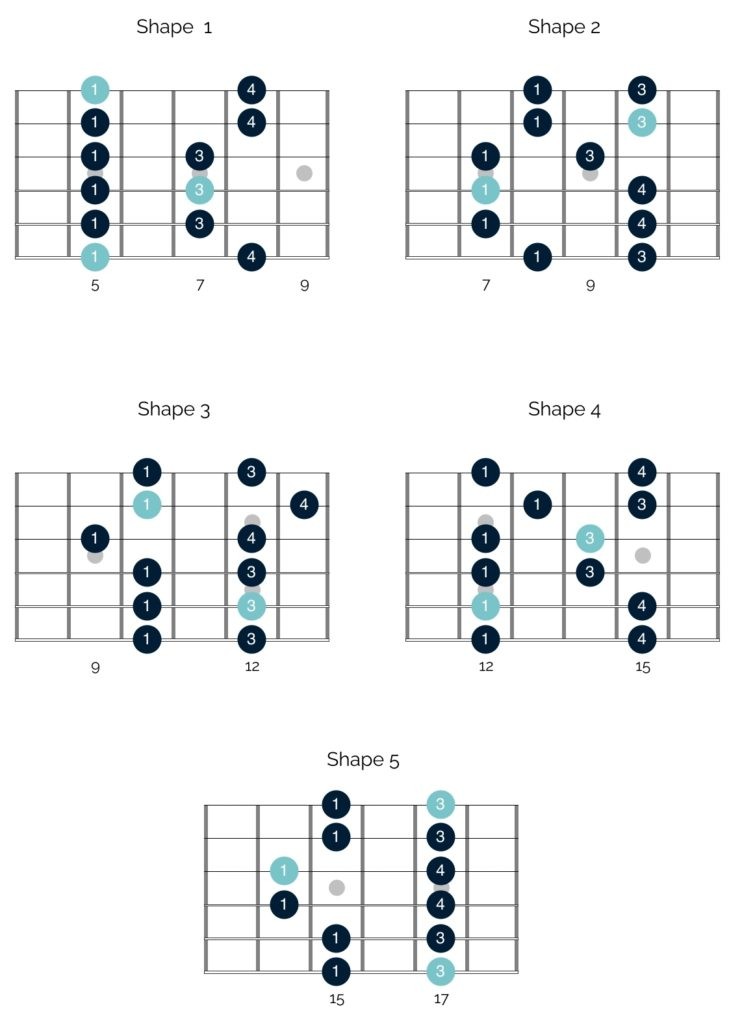Learning the minor pentatonic scale is a fundamental step for any aspiring lead guitarist, especially in blues and rock genres. This comprehensive guide provides a detailed breakdown of the scale, its shapes, and how to apply it effectively in your playing.
Understanding the Minor Pentatonic Scale
The minor pentatonic scale is a five-note scale, hence “penta,” derived from the Greek word for five. It’s a simplified version of the natural minor scale, omitting two notes. In the key of A, the A natural minor scale is A-B-C-D-E-F-G, while the A minor pentatonic scale is A-C-D-E-G. These five notes provide a framework for countless iconic riffs and solos in blues and rock music.
Mastering the Five Shapes
The minor pentatonic scale has five distinct shapes or patterns that can be played across the fretboard. Learning these shapes is crucial for navigating the guitar neck and improvising freely. Each shape is built off a different note of the scale, and they remain consistent regardless of the key. Only their position on the fretboard changes.
Shape 1: This is the most recognizable and easiest shape to learn, often serving as a starting point for beginners.
Shape 2: This shape connects smoothly with Shape 1, facilitating transitions between the two.
Shape 3: This shape introduces a slight shift on the B string, requiring a little more practice to master.
Shape 4: Similar to Shape 3, this shape also involves a shift on the B string. Mastering this shape unlocks melodic possibilities on the higher strings.
Shape 5: This symmetrical shape, while often underutilized, allows for smooth transitions and unique licks.
Connecting the Shapes: Navigating the Fretboard
Once familiar with the individual shapes, the next step is understanding how they connect across the fretboard. Visualizing the entire scale across the neck reveals a continuous pattern, allowing for seamless transitions between positions.
Playing in Different Keys
Changing keys with the minor pentatonic scale is straightforward. Memorize the root notes on the 6th string. Locate the root note of your desired key on the 6th string; this becomes the starting point for Shape 1. The remaining shapes follow the same pattern relative to the new root note.
Effective Practice Techniques
Consistent practice is essential for internalizing the minor pentatonic scale. Two helpful exercises include:
Exercise 1: Rhythmic Precision: Play two notes per metronome click, slowly and accurately, focusing on timing and clean articulation. Gradually decrease the tempo for an increased challenge.
Exercise 2: Chromatic Runs: Play each shape chromatically up and down the neck, four notes per metronome click. This exercise builds speed, stamina, and fretboard familiarity.
Applying the Minor Pentatonic Scale
The minor pentatonic scale works seamlessly over minor key chord progressions. Interestingly, it also sounds great over major blues progressions due to the inherent dissonance within dominant 7th chords, a cornerstone of blues music. Legendary guitarists like Eric Clapton and Jimi Hendrix extensively used this characteristic.
Conclusion
The minor pentatonic scale is a powerful tool for any guitarist. By understanding its structure, mastering its shapes, and practicing diligently, you’ll unlock a world of soloing and improvisational possibilities. This knowledge will form a solid foundation for your guitar journey.

